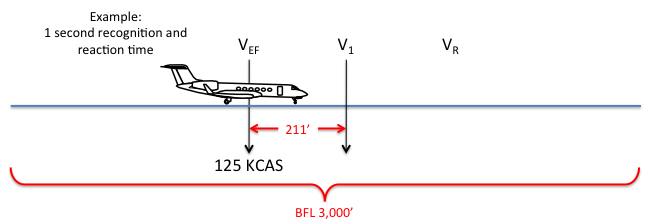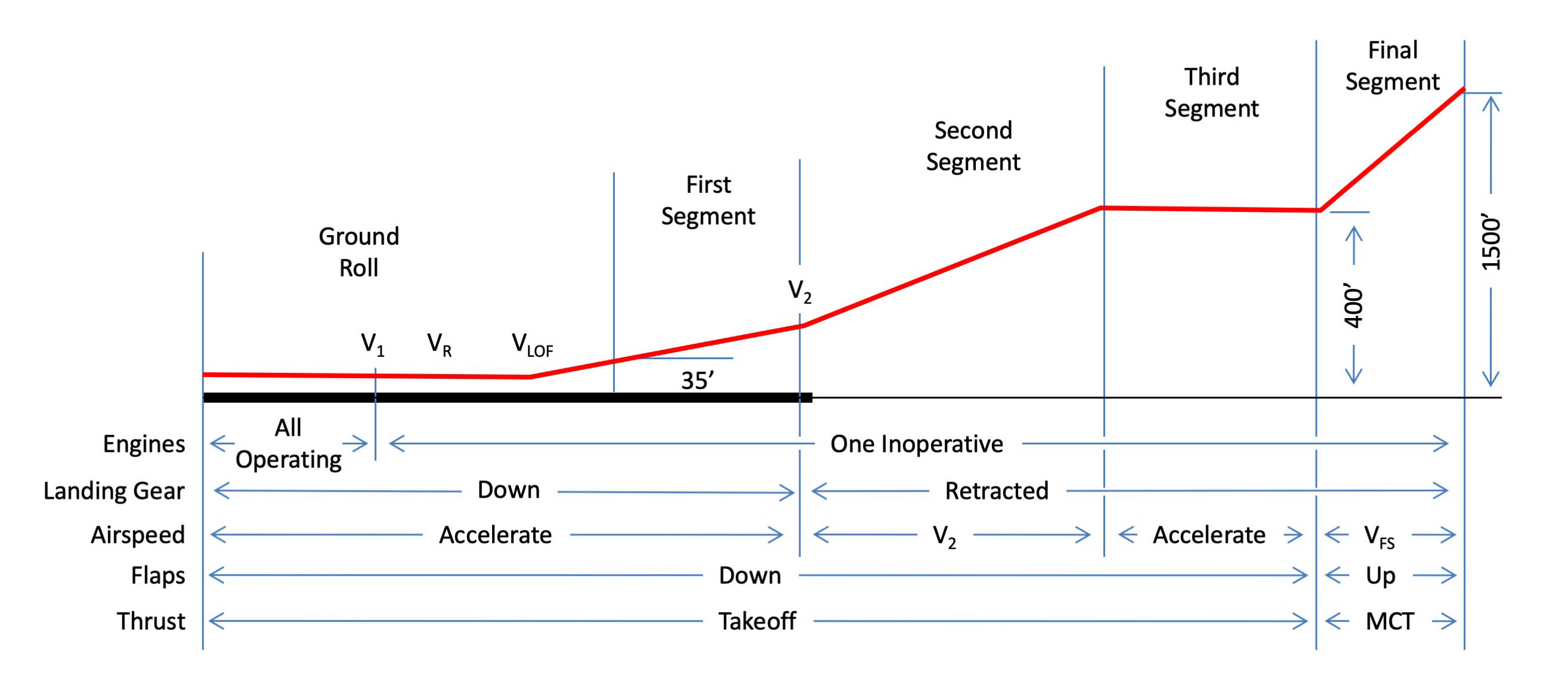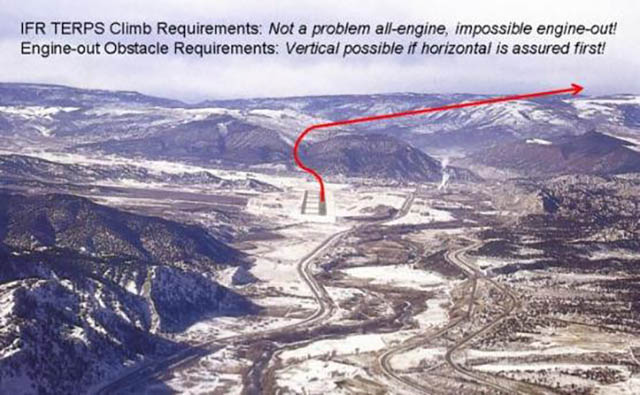What do you have to consider prior to every takeoff? The list is very look, perhaps endless.
— James Albright

Updated:
2013-12-17
What follows are discussions of each of these topics with links to where the real information resides.

1
Flap selection
Source:
Generally speaking, if the aircraft has a choice of takeoff flap setting, a higher flap angle will reduce runway length required but will also reduce climb gradient. For example, in a G450 using two conditions:
Going from 10° flaps to 20° flaps reduced the effective runway length required by around 10% in our two example cases.
| GWT | Temp | P.A. | 10° Flaps | 20° Flaps |
|---|---|---|---|---|
| 60,000 | 30°C | 4,000' | 5,500' | 5,000' |
| 65,000 | 20°C | S.L. | 4,750' | 4,400' |
Going from 10° flaps to 20° flaps reduced the climb gradient by around 15% in our two example cases.
| GWT | Temp | P.A. | 10° Flaps | 20° Flaps |
|---|---|---|---|---|
| 60,000 | 30°C | 4,000' | 6.6% | 5.7% |
| 65,000 | 20°C | S.L. | 7.7% | 6.4% |
For more about this, using the G450 as an example: https://www.code450.com/flap-selection.
2
Thrust reduction
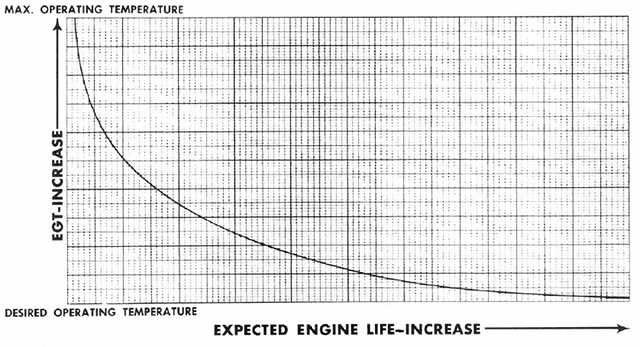
Expected Engine Life, from 1C-135(E)C-1, Figure 7-3A.
One could argue that the benefits of reducing takeoff thrust settings on a modern engine are not as significant as they used to be: engines are more reliable, are designed to operate at higher turbine temperatures, and are computer monitored and controlled. I would argue that modern engines are also much more expensive and if the manufacturer recommends you do it, you should.
For more about these topics:
3
Performance
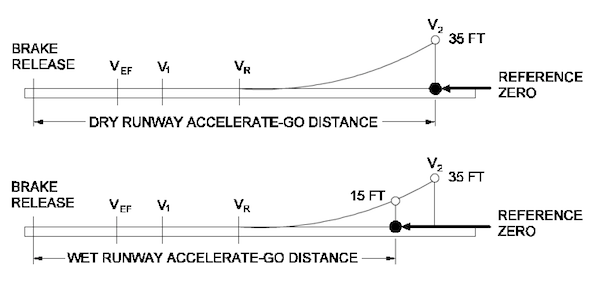
Reference zero, from G450 Airplane Flight Manual §5.1, pg. 5.1-5.
The aircraft flight manual should contain all you need to know to safely extract the necessary takeoff performance from your aircraft.
More about this for the G450 crowd: https://www.code450.com/takeoff-data.
4
Ground control
Below VMCG you are relying on nosewheel steering to keep you on the runway, above this speed you are relying on the aerodynamics of the airplane to keep you going straight after no more than a 30 foot excursion from centerline. You would expect VMCG to vary with aircraft thrust, weight, temperature, and pressure altitude.
The G450 pilot should understand that the published VMCG, 109 KCAS, is probably not an accurate number for any given takeoff. It is probably "about right," but your V1 will always be at least VMCG so you should never rotate before V1 because your control on the ground before this speed depends on nosewheel steering.
More about this: VMCG - Minimum Control Speed Ground.
5
Decision speed
Many aircraft manufacturers, Gulfstream included, call V1 "Decision Speed." The problem with that is the decision must already have been made by V1 and the action to either abort or continue the takeoff must be in progress by then.
More about this: V1 - Decision Action Speed.
6
Air control
If you lose the critical engine you should be able to maintain directional control with no more than a 20° excursion from your desired heading using no more than 5° of bank. You should be able to do this with the operating engine at takeoff power, the flaps set at their takeoff position, the gear retracted, and outside of ground effect. All that being said, the regulation allows the manufacturer to set this speed at sea level and at a weight of their choosing ("or any lesser weight necessary to show VMC."). In other words, VMC is a made up number that may or may not deliver what you are expecting. My advice: the number is advisory, keep it in mind, but realize it might not be enough to keep you in control.
Gulfstream confuses things a bit by declaring two varieties of minimum control speeds. VMCA is "Minimum Control Speed, Air" and is in the takeoff configuration. VMCL is "Minimum Control Speed, Landing" and is in the landing configuration. Gulfstream does not provide any charts for VMCA, but does provide a number (106 KCAS) with the statement it is "the lowest speed..." Your slowest V2 (Takeoff Safety Speed) is significantly higher, 130 knots for a very light G-450. Fortunately the aircraft comes with many slow speed cues that are far more valuable to you that this artificial number.
More about this: VMC - Minimum Control Speed.
7
Climb requirements (design)
Minimum design climb performance is specified by 14 CFR 25 and represents the baseline for what you, the average pilot, can expect from your aircraft if you operate it as the manufacturer intended.
More about this: Takeoff Climb Gradient Requirements.
8
Climb requirements (SID)
Standard Instrument Departure (SID) requirements are specified by TERPS and assume everything is working, no engine failures. If you plan on meeting these requirements only with all engines operating, you need to have a "Plan B." Specifically, you will have to declare an emergency to let air traffic control know that you might not be making the TERPS climb requirements, and you will have to have considered obstacle clearance. Why would you do this? You get more payload capability.
More about that: Departure Obstacle Avoidance.
9
Climb requirements (obstacles)
You must consider obstacle clearance with the loss of an engine at V1 prior to takeoff. Your clearance requirements include horizontal as well as vertical requirements. If you understand the three-dimensional issues, you may be able to takeoff considerably heavier than simply using TERPS criteria.
More about this: Departure Obstacle Avoidance.
References
(Source material)
14 CFR 25, Title 14: Aeronautics and Space, Airworthiness Standards: Transport Category Airplanes, Federal Aviation Administration, Department of Transportation
Gulfstream G450 Aircraft Operating Manual, Revision 35, April 30, 2013.
Gulfstream G450 Airplane Flight Manual, Revision 35, April 18, 2013
Gulfstream G450 Operational Information Supplement, G450-OIS-02, Contaminated Runway Performance, Revision 1, August 3, 2011
Gulfstream G450 Performance Handbook, GAC-AC-G450-OPS-0003, Revision 20, November 30, 2011
Technical Order 1C-135(E)C-1, EC-135C Flight Manual, USAF Series, 15 February 1966.
United States Standard for Terminal Instrument Procedures (TERPS), Federal Aviation Administration 8260.3B CHG 25, 03/09/2012
Please note: Gulfstream Aerospace Corporation has no affiliation or connection whatsoever with this website, and Gulfstream does not review, endorse, or approve any of the content included on the site. As a result, Gulfstream is not responsible or liable for your use of any materials or information obtained from this site.


